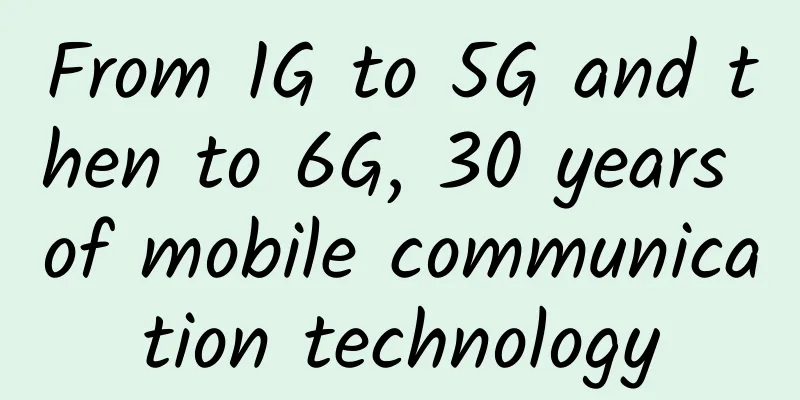From 1G to 5G and then to 6G, 30 years of mobile communication technology

|
Since the 1980s, mobile communications have seen the emergence of new generations of revolutionary technologies basically every ten years, continuously accelerating the iteration and upgrading of the information industry, and constantly promoting the prosperity and development of the economy and society. It has now become an indispensable basic information network connecting human society. People's endless pursuit of information needs has promoted the further development of mobile communication technology. Mobile communications have gradually developed from 1G to the current 5G. At present, 5G has begun to be deployed on a large scale around the world, and many countries have included 6G in their national plans for the next few years. After 1980, 1G became popular 1G, the first generation of mobile communication technology, is a cellular wireless telephone system that uses analog signals as transmission carriers. At the end of 1978, Bell Laboratories in the United States successfully developed the world's first mobile cellular telephone system AMPS; In 1980, four Nordic countries, including Sweden, Denmark, Norway and Finland, successfully developed the NMT-450 network; In 1983, AMPS was officially put into commercial use in Chicago, USA and quickly promoted throughout the United States. The United States became the first country to use the AMPS network. In 1984, Germany completed the C-Netz; In 1985, the UK developed the 900MHz (TACS, Total Access Communications System) network; On November 18, 1987, my country's first generation analog communication system was launched and officially put into commercial use, using the British TACS standard full-access communication system. After 1995, 2G became popular 2G, the second generation of mobile communication technology, is based on digital voice transmission technology. 2G has higher confidentiality and larger system capacity than 1G. In 1991, Europe launched the "Global System for Mobile Communications" (GSM), which was the "Global System for Mobile Communications" that we used to use when we bought phone cards at the business hall. In 1995, my country officially entered the 2G era. The second-generation mobile communications, which mainly used GSM and supplemented by IS-95 and CDMA, developed nearly 300 million users in ten years. On January 8, 2002, China Unicom officially launched the CDMA network and put it into commercial use. CDMA technology has the advantages of large system capacity, high confidentiality, green environmental protection, and strong anti-interference ability. In October 2019, the Ministry of Industry and Information Technology stated that the conditions for the withdrawal of 2G and 3G networks have gradually matured, and encouraged operators to actively guide users to migrate to other networks. As the longest-running and most technologically mature network, the 2G network will eventually withdraw from the mobile communications stage with the arrival of new technologies. After 2009, 3G became popular 3G is the third generation of mobile communication technology, which refers to cellular mobile communication technology that supports high-speed data transmission. Compared with 2G, 3G has faster speed, larger bandwidth and better user Internet experience. In May 2000, the International Telecommunication Union officially announced the third-generation mobile communication standard. my country's TD-SCDMA officially became an international standard, and became one of the three most mainstream technologies in the 3G era along with Europe's WCDMA and the United States' CDMA2000. China's participation has once again changed the pattern of wireless communications: the 1G era was dominated by one company, the 2G era saw two strong competitors, and the 3G era saw a three-way confrontation. However, the 3G era in my country was very short. 3G licenses were issued in 2009 and 4G licenses were issued in 2014, which is only five years in total. After 2013, 4G became popular 4G, the fourth generation mobile phone communication standard, includes two formats, TD-LTE and FDD-LTE, integrating 3G and WLAN. 4G's MIMO, or multiple-input multiple-output antenna technology, improves frequency reuse, which is equivalent to making the road wider by building more lanes, accommodating multiple vehicles driving side by side at the same time. Cross-carrier aggregation can obtain a larger spectrum bandwidth and thus increase the data rate. 4G network speeds are roughly 10 times faster than 3G networks. 4G-related technologies not only increase the speed from 10Mbps in the 3G era to 100Mbps, but also lay the technical foundation for the evolution to 5G. On December 4, 2013, the Ministry of Industry and Information Technology officially issued the fourth-generation mobile communications service TD-LTE licenses (i.e. 4G licenses) to China Mobile, China Telecom and China Unicom. In addition, China Unicom and China Telecom will each obtain an FDD-LTE license. Whether it is 3G or 4G, the licenses issued by my country are 5-10 years later than those issued by foreign countries. Although followers do not need to pay too much cost to enjoy the dividends brought by technology, they are still subject to the control of others. The 5G Era is Coming 5G, the fifth generation of communication technology, is mainly characterized by ultra-wideband, ultra-high speed and ultra-low latency. On June 6, 2019, the Ministry of Industry and Information Technology officially issued 5G commercial licenses to China Telecom, China Mobile, China Unicom, and China Broadcasting Corporation, and China officially entered the first year of 5G commercialization. 4G has changed our lives, and 5G has far exceeded the impact on personal life and has become an important part of national infrastructure. Among the three major application scenarios defined by 5G, mMTC (massive machine type communications) is an application for large-scale Internet of Things services. The Internet of Things enables every device from public infrastructure to factories to homes to be connected, involving all aspects of production and life. The availability, reliability, stability and security of 5G networks are particularly important, and their status can be elevated to the level of national strategy. The revolutionary significance of 5G is not the dimension of the transition from 3G to 4G, but is related to the interests of the entire country. 6G is already here In early 2019, US President Trump publicly stated that he would accelerate the development of 6G technology in the United States. In March 2019, the University of Oulu in Finland hosted the world's first 6G Summit. Based on the opinions of experts at the 6G Summit, the University of Oulu released the world's first 6G white paper in October 2019, proposing that 6G will be deployed around 2030, 6G services will seamlessly cover the world, and artificial intelligence will be deeply integrated with 6G networks. At the same time, key indicators such as 6G network transmission speed, frequency band, latency, and connection density were proposed. In April 2019, the Korea Institute of Communications and Information Science held a 6G forum, officially announcing the start of 6G research and the establishment of a 6G research group whose mission is to define 6G and its use cases/applications and develop 6G core technologies. In June 2019, Neil McRae, chief network architect of British Telecom Group (BT), predicted that 6G will be commercialized in 2025. Its features include "5G+satellite network (communication, telemetry, navigation)", cost-effective ultra-fast broadband achieved by technologies such as "wireless fiber optic", widely deployed "nanoantennas", and flying sensors. On November 3, 2019, China established the National 6G Technology R&D Promotion Working Group and the Overall Expert Group, marking the official launch of China's 6G R&D. The evolution of communication technology is also the evolution of social development. From 1G to 5G and then to 6G, we have seen mankind's tireless pursuit of science and technology, and the great changes that science and technology have brought to people's lives; we have experienced the changes of the leaders of communication technology from North America to Europe to Asia, and have also personally felt the high-intensity suppression from other developed countries. If we want to gain an advantage in the mobile communication track and become an international standard setter, we must strengthen ourselves! |
<<: Communications man, what on earth have you done to Everest?
>>: Why are the salaries of network engineers so different?
Recommend
Gartner lamented that there has never been such a volatile market in 25 years
According to Gartner's forecast, global IT sp...
Understand HTTP and HTTPS protocols in ten minutes?
[[276795]] 1. What is a protocol? A network proto...
From entry to mastery: Application and best practices of Ansible Shell modules
Ansible is a powerful automated operation and mai...
Enlightenment on using Smallcell to solve deep network coverage in the post-5G era
1. Current status of network coverage in the post...
VULTR adds 32nd data center in the world: Tel Aviv, Israel
In February this year, we shared the news that VU...
Passive Optical Network (PON) Technology Video Surveillance System Solution
Faced with the rapid growth of security services ...
ITLDC offers 50% discount on down payment, 11 data centers to choose from, unlimited traffic VPS starting from 16.5 euros for the first year
ITLDC has released a 50% discount code for all VP...
Huawei's ecosystem is expected to prosper exponentially in response to demand
【51CTO.com original article】 As we all know, in t...
WePC: 232 yuan/year Los Angeles VPS triple-network backhaul cmin2/9929/cn2, 512MB/10G NVMe/500GB@300Mbps
At the end of last month, I shared the informatio...
5G brings precise positioning to the Internet of Things
Cellular has ‘all the ingredients’ to enhance pre...
Ruijie Networks: Boao Business Forum concluded, Ruijie Cloud Desktop IDV all-in-one machine won the "Ingenuity Product Award"
Recently, the "2021 Boao Enterprise Forum&qu...
StarryDNS Spring Promotion: $5/month-2GB/20GB/1TB@150Mbps/Tokyo/Osaka Data Center, Japan
StarryDNS is a hosting company registered in Hong...
spinservers: San Jose/Dallas 10Gbps high-end servers starting at $89/month
This month, spinservers launched a large number o...
Huawei launches LampSite X indoor digital innovation solution to unleash the unlimited potential of the digital world
[Dubai , UAE , October 11, 2023 ] During the 2023...
Huawei's Wu Hui: Join hands with partners to be the "bridge builders" and "road builders" of the intelligent era
Every generation has its own mission of transform...









